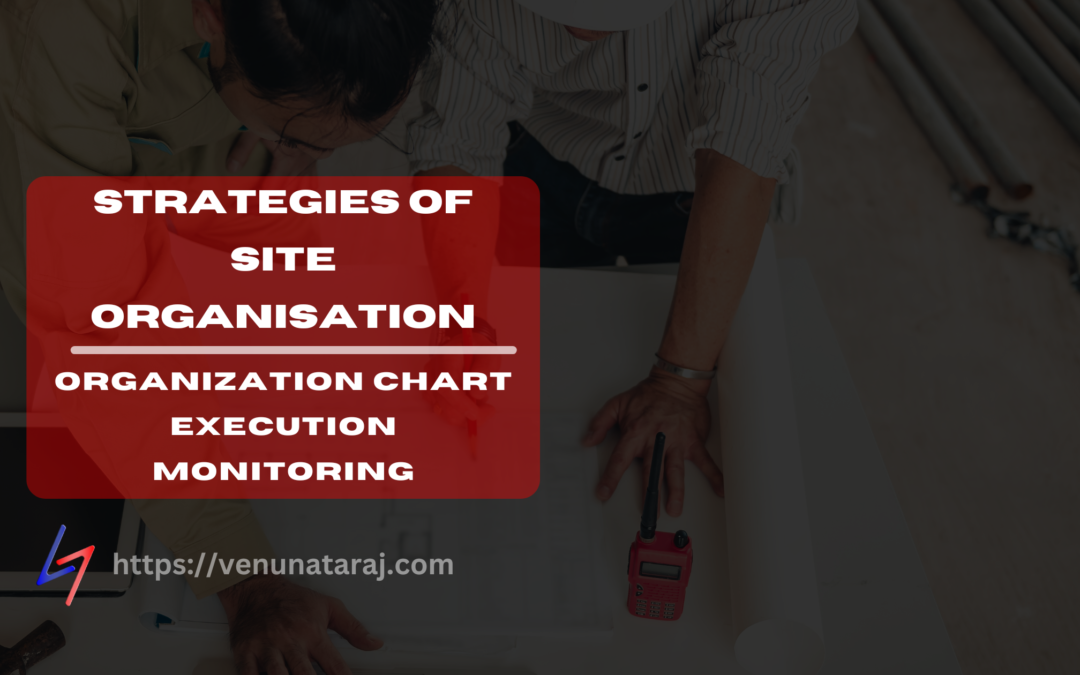3 Essential Strategies for Site Organization in Construction
This comprehensive exploration of site organization in construction projects illuminates the critical role of organization charts and execution and monitoring processes. By integrating these components effectively, project managers empower their teams to achieve excellence in project delivery.
Table of Contents
Understanding Site Organization in Construction Projects
In the realm of construction project management, effective site organization serves as the cornerstone for successful project execution. From defining roles and responsibilities to establishing communication channels, the structure of site organization profoundly impacts project outcomes. Let’s delve into the intricacies of two critical components of site organization: the organization chart and the execution and monitoring process.
Organization Chart: Mapping the Path to Success
Importance and Structure
Definition:
An organization chart, often likened to a roadmap, delineates the hierarchical structure of a construction project team.

Importance:
- Provides clarity: Organization charts help team members understand their roles and reporting lines, reducing confusion and improving efficiency.
- Enhances communication: By visualizing the structure of the project team, organization charts facilitate communication and coordination among team members.
- Supports decision-making: Clear delineation of roles and responsibilities enables effective delegation of tasks and decision-making within the project team.
Structure:
- Hierarchical layout: Typically, organization charts are arranged in a hierarchical format, with higher-level positions positioned above lower-level positions.
- Reporting relationships: Lines connecting positions indicate reporting relationships, illustrating who reports to whom within the project team.
- Position titles: Each position within the organization chart is labeled with a title, such as project manager, department head, or team leader.
Components and Elements
Positions or Titles:
Project Manager: Responsible for overall project planning, execution, and control.
Department Heads: Heads of functional departments, such as engineering, procurement, and construction, overseeing departmental activities.
Team Leaders: Leaders of project teams or work crews, responsible for managing day-to-day operations and coordinating team activities.
Lines of Authority and Communication:
Solid Lines: Represent formal reporting relationships, indicating direct lines of authority and communication within the project team.
Dotted Lines: Indicate informal or advisory relationships, such as dotted lines between project managers and functional department heads.
Relationships between Departments or Divisions:
Horizontal Relationships: Connections between positions at the same hierarchical level, indicating collaboration or coordination between departments or divisions.
Vertical Relationships: Lines connecting positions at different hierarchical levels, illustrating reporting relationships and chains of command.
Execution and Monitoring: Guiding Projects to Completion

Mobilization of Materials and Equipment on Site Management
- Coordination of Resources Delivery: Ensure timely delivery of materials and equipment to the construction site, coordinating with suppliers and logistics providers.
- Proper Storage and Handling: Establish protocols for the storage and handling of materials and equipment on-site, minimizing damage and ensuring safety.
- Tracking and Monitoring: Implement systems to track the utilization of materials and equipment, monitoring usage levels and replenishing supplies as needed.
Work Completion and Finalization
- Ensuring Completion: Monitor progress towards project milestones and deadlines, ensuring that all project tasks are completed on schedule.
- Final Inspections and Quality Checks: Conduct final inspections and quality checks to verify that all work meets project specifications and quality standards.
- Client Approval and Sign-Off: Obtain client approval and sign-off on completed work, ensuring satisfaction and acceptance of deliverables.
Preparation of Final Bill
- Compilation of Expenses: Gather data on project expenses, including labor costs, material costs, equipment rentals, and subcontractor fees.
- Calculation of Costs: Calculate the total cost of the project, including direct costs, indirect costs, and overhead expenses.
- Generation of Final Invoice: Prepare the final invoice based on the compiled expenses, ensuring accuracy and completeness in billing.
Reconciliation of Materials
- Matching Material Usage: Compare actual material usage with planned quantities, identifying any discrepancies or variances.
- Addressing Discrepancies: Investigate discrepancies in material usage and take corrective action, such as adjusting inventory records or investigating potential waste.
- Updating Inventory Records: Update inventory records to reflect accurate material usage, ensuring that stock levels are properly accounted for.
Plant and Equipment Utilization Statement
- Assessment of Equipment Usage: Evaluate the utilization of plant and equipment on the construction site, analyzing usage rates and downtime.
- Identification of Efficiency Improvements: Identify opportunities to improve equipment utilization and efficiency, optimizing resource allocation and minimizing downtime.
- Planning for Maintenance and Replacement: Develop maintenance schedules and replacement plans for plant and equipment, ensuring continued reliability and performance.
List of Defects
- Compilation of Identified Defects: Create a comprehensive list of defects or issues identified during project execution, including construction defects, safety hazards, or quality deficiencies.
- Documentation of Corrective Actions: Document the corrective actions taken to address each defect, detailing the steps taken to rectify the issue and prevent recurrence.
- Verification of Defect Resolution: Verify that all identified defects have been effectively resolved before project closure, ensuring that the final deliverables meet quality standards.
Conclusion:
In conclusion, site organization stands as the guiding beacon in the labyrinth of construction projects. Through clear organization charts and meticulous execution and monitoring processes, project teams navigate challenges, mitigate risks, and drive projects to successful completion. With a keen eye on communication, collaboration, and quality, construction project management transcends mere coordination to orchestrate symphonies of success.
Further Reads:
Site Organization Types: 3 types of Site Organization in Construction Projects
Warehouse and Store Management: Warehouse Management and Store Managements in Construction

